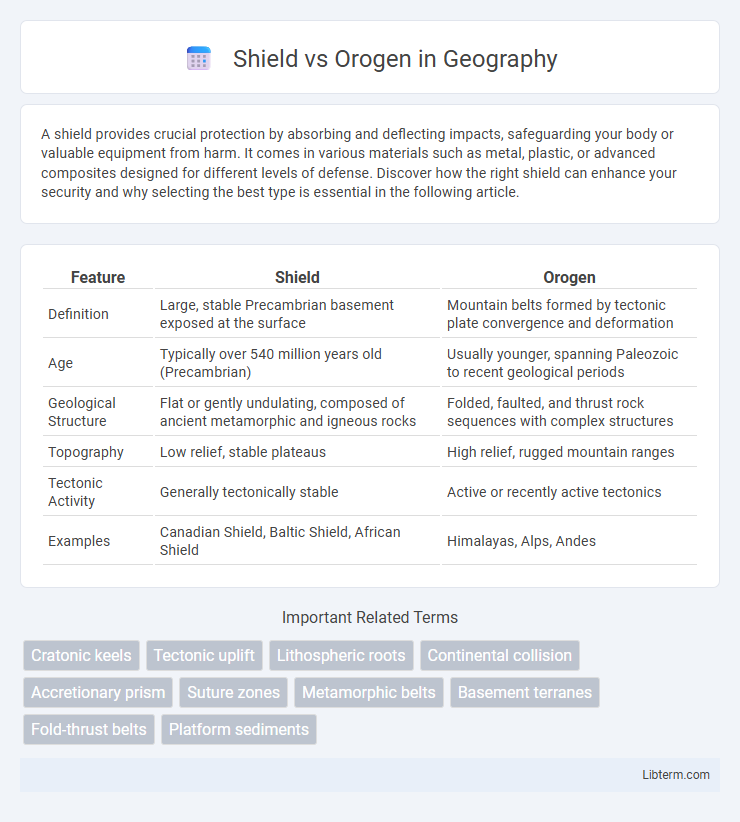A shield provides crucial protection by absorbing and deflecting impacts, safeguarding your body or valuable equipment from harm. It comes in various materials such as metal, plastic, or advanced composites designed for different levels of defense. Discover how the right shield can enhance your security and why selecting the best type is essential in the following article.
Table of Comparison
| Feature | Shield | Orogen |
|---|---|---|
| Definition | Large, stable Precambrian basement exposed at the surface | Mountain belts formed by tectonic plate convergence and deformation |
| Age | Typically over 540 million years old (Precambrian) | Usually younger, spanning Paleozoic to recent geological periods |
| Geological Structure | Flat or gently undulating, composed of ancient metamorphic and igneous rocks | Folded, faulted, and thrust rock sequences with complex structures |
| Topography | Low relief, stable plateaus | High relief, rugged mountain ranges |
| Tectonic Activity | Generally tectonically stable | Active or recently active tectonics |
| Examples | Canadian Shield, Baltic Shield, African Shield | Himalayas, Alps, Andes |
Introduction to Shields and Orogens
Shields are vast, stable areas of exposed Precambrian crystalline rocks that form the ancient cores of continents, characterized by low tectonic activity and significant geological stability. Orogens represent tectonically active zones where mountain-building processes occur due to the collision, subduction, or rifting of lithospheric plates, resulting in deformation, metamorphism, and crustal thickening. The contrasting nature of shields and orogens highlights the dynamic interplay between stable continental interiors and actively evolving mountain belts within Earth's lithosphere.
Geological Definitions: What Are Shields?
Shields are large, stable areas of exposed Precambrian crystalline igneous and metamorphic rocks forming the ancient geological core of continents. These regions are characterized by highly resistant basement rocks that have remained relatively tectonically inactive for over a billion years. Shields contrast with orogens, which are zones of intense deformation, mountain building, and younger tectonic activity.
Geological Definitions: What Are Orogens?
Orogens are regions of the Earth's crust where tectonic plate collisions have caused intense deformation, mountain building, and metamorphism, typically characterized by folded and faulted rock strata. Unlike shields, which are stable, ancient crystalline cores with minimal tectonic activity, orogens represent zones of active geological processes such as subduction, crustal thickening, and magmatism. These dynamic geological environments form mountain ranges and play a crucial role in the recycling and reconstruction of the continental lithosphere.
Formation Processes: Shield vs Orogen
Shields are ancient, stable cratonic regions composed primarily of exposed Precambrian crystalline basement rocks, formed through prolonged geological stability and minimal tectonic disruption. Orogens, in contrast, result from the convergence and collision of tectonic plates, leading to mountain-building processes such as folding, faulting, and metamorphism. The formation of shields involves long-term cooling and erosion, while orogens develop dynamically over shorter geological timescales through intense deformation and crustal thickening.
Age and Composition Differences
Shields, some of the oldest geological formations on Earth, date back to the Precambrian era, often exceeding 2.5 billion years in age. They are predominantly composed of highly metamorphosed igneous and high-grade metamorphic rocks such as granite and gneiss. In contrast, orogens form during tectonic plate collisions, resulting in younger, complex belts of deformed sedimentary, volcanic, and metamorphic rocks typically ranging from Paleozoic to recent geological periods.
Tectonic Stability: Shields vs Orogens
Shields represent ancient, tectonically stable continental cores composed of Precambrian crystalline basement rocks that have experienced minimal deformation over billions of years. Orogens, in contrast, are regions of recent or ongoing tectonic activity characterized by mountain-building processes, intense deformation, and crustal thickening. The fundamental difference in tectonic stability is reflected in shields' subdued topography and lithospheric rigidity versus the dynamic, structurally complex, and often seismically active nature of orogenic belts.
Economic Importance: Mineral Resources
Shield regions, such as the Canadian Shield, are exceptionally rich in mineral resources including gold, silver, iron ore, and nickel, driving significant mining industries and economic development. Orogens, formed by mountain-building processes, often contain valuable deposits of minerals like copper, lead, zinc, and precious metals due to complex geologic formations and tectonic activity. Exploitation of these mineral resources in both shields and orogens is crucial for industries ranging from electronics to construction, contributing substantially to national economies.
Distribution and Global Examples
Shields are large, stable Precambrian crustal blocks that form the cores of continents, commonly exposed in regions like the Canadian Shield, the Baltic Shield, and the African Shield. In contrast, orogens are zones of active or past mountain building typically found along convergent tectonic plate boundaries, with prominent examples including the Himalayas, the Andes, and the Alps. The global distribution of shields highlights ancient, tectonically stable areas, while orogens mark more geologically dynamic regions where crustal deformation and uplift occur.
Role in Plate Tectonics
Shields represent the stable, ancient cores of continents composed of Precambrian crystalline rocks that provide a rigid foundation for tectonic plates. Orogens are zones of intense deformation, mountain-building, and crustal thickening formed by plate convergence, subduction, and continental collision. The contrast between shields' stability and orogens' dynamic processes highlights their pivotal roles in plate tectonics, where shields anchor plates and orogens mark active boundaries shaping Earth's topography.
Shields and Orogens: Implications for Earth's Evolution
Shields represent the ancient, stable cores of continental lithosphere, composed mainly of Precambrian crystalline basement rocks that have remained tectonically inactive for billions of years. Orogens are dynamic zones of mountain building formed by plate collisions, characterized by intense deformation, metamorphism, and magmatism that continuously reshape the Earth's crust. Studying the contrast between Shields and Orogens reveals the interplay between crustal stability and tectonic activity, providing critical insights into the processes driving Earth's lithospheric evolution and continental assembly over geological time.
Shield Infographic

 libterm.com
libterm.com